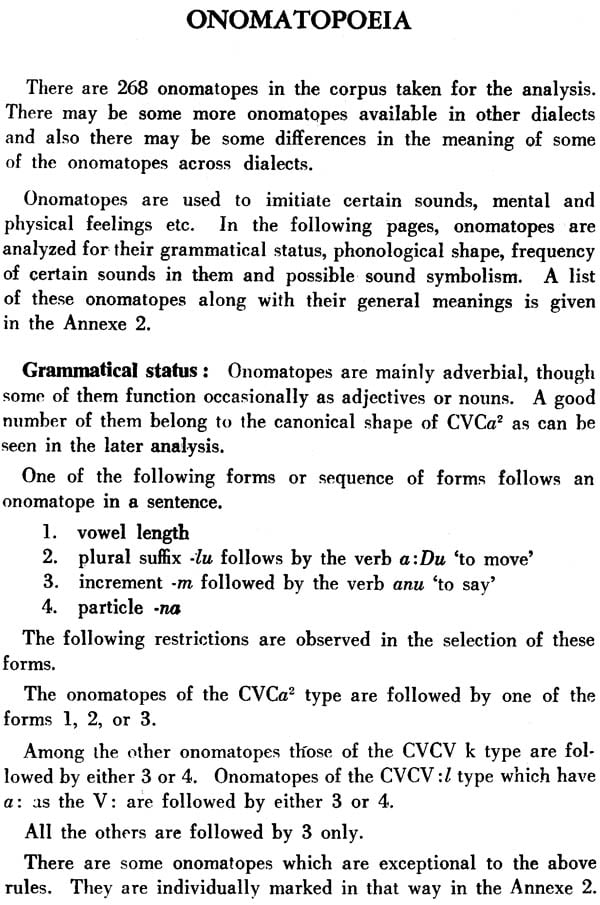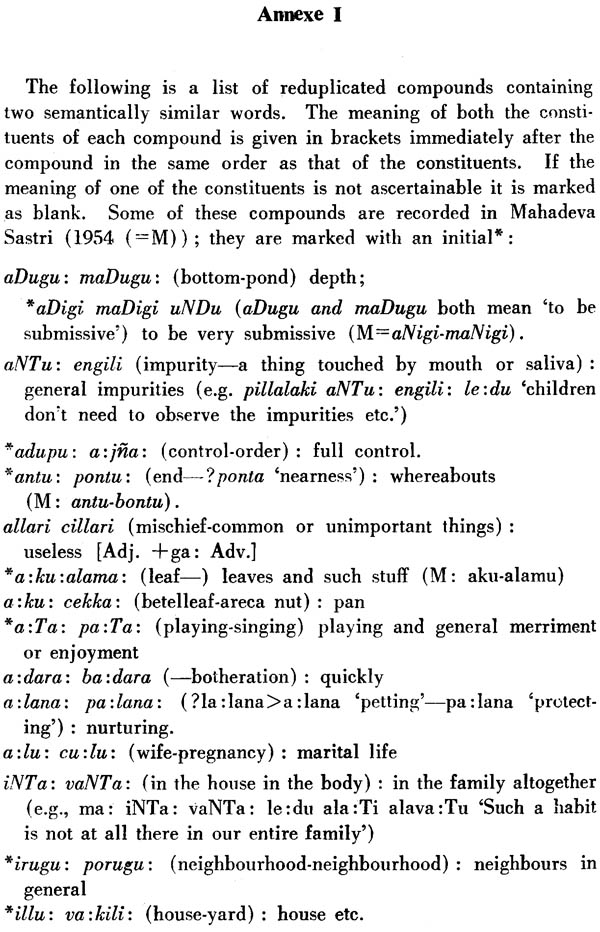
Reduplication and Onomatopoeia in Telugu (An Old and Rare Book)
Book Specification
| Item Code: | NAM049 |
| Author: | Peri Bhaskararao |
| Publisher: | Deccan College Postgraduate and Research Institute |
| Language: | English |
| Edition: | 1977 |
| Pages: | 56 |
| Cover: | Paperback |
| Other Details | 8.5 inch x 5.5 inch |
| Weight | 70 gm |
Book Description
In this book the process of reduplication and formation of onomatopes in Telugu are presented. Telugu utilizes the reduplication process for bringing out various subtle meaning differences. Under the heading of reduplication we shall also cover the formation of echo-words. Reduplication and onomatopoeia could be taken together because a large number of onomatopoeia could be taken together because a large number of onomatopes appears in a reduplicated form. Though Telugu makes use of these words to a good extent, this phenomenon is not specific to Telugu only. The languages of South Asia have extensive repertoires of onomatopes. Some of the languages have been analyzed from this angle (Apte: 1968). The most extensive work so far on Telugu intensive and inclusive compounds is by Mahadeva Sastri (1954). Apte (1968) makes a general and exhaustive survey of the definitions of the terms reduplications, echo-words and onomatopoeia. In this work we differ from his definition of these terms to certain extent—for instance, we consider echo-word formation as a kind of reduplication.
Material for analysis is taken from the Northern coastal (Kalinga) dialect of Telugu. On some occasions, Telugu dictionaries (Si:ta:ra:ma:ca:ryulu (1958) and Su:ryara:ya:ndhranighaNTuvu) were consulted. As far as the onomatopes are concerned the Telugu dictionaries are very deligent, since the older Telugu literature has made extensive use of the onomatopes—sometime a whole poem is replete with them—these dictionaries which record the literary forms have recorded them very carefully. They occasionally record some onomatopes that are not attested in the literature but used colloquially.
Following the standerd alphabetical order, the phonemes of colloquial Telugu (particularly of the dialect under study) are: vowels: a a: i i: u u: e e: o o: and consonants: k g c j TDN tdn pbm yr IL v s Sh. All the stops have aspirated counterparts as phonemes in the very formal or careful pronunciation—they come after the respective unaspirated phonemes in the alphabet.
In the case of some onomatopes the aspirated sounds are found to alternate freely with their unaspirated counterparts. In addition, aspiration has an extra function of bringing out emphasis. The capital symbols stand for retroflexes. The retroflex fricative occurs only in one onomatope. There is a voiceless palatal fricative as available in careful pronunciation but not seen in the onomatopes. The voiceless labiodental fricative f is available in the subsystem of the phonology of borrowed words. But this sound is also found in one of the onomatopes.
| Introduction | i |
| Reduplication | 1-11 |
| Total reduplication | 1 |
| Partial reduplication or echo formation | 6 |
| Compounding of semantically connected words | 10 |
| Onomatopoeia | 12-32 |
| Grammatical status | 12 |
| Structure | 14 |
| Sound-meaning relation | 22 |
| Other grammatical functions | 27 |
| Relation with other words | 28 |
| Usage of onomatopes | 29 |
| Annexe 1 | 33 |
| Annexe 2 | 38 |
| Biblography | 50 |









